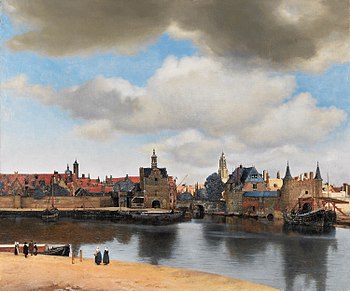Oil paint

Oil paint is a type of slow-drying
History
The technical history of the introduction and development of oil paint, and the date of introduction of various additives (driers, thinners) is still—despite intense research since the mid 19th century—not well understood. The literature abounds with incorrect theories and information: in general, anything published before 1952 is suspect.[1] Until 1991 nothing was known about the organic aspect of cave paintings from the Paleolithic era. Many assumptions were made about the chemistry of the binders. Well known Dutch-American artist Willem de Kooning is known for saying "Flesh is the reason oil paint was invented".[2]
First recorded use
The oldest known oil paintings are Buddhist murals created c. 650 AD. The works are located in cave-like rooms carved from the cliffs of Afghanistan's
Classical and medieval period
Though the ancient Mediterranean civilizations of
Greek writers such as
Early Christian monks maintained these records and used the techniques in their own artworks. Theophilus Presbyter, a 12th-century German monk, recommended linseed oil but advocated against the use of olive oil due to its long drying time. Oil paint was mainly used as it is today in house decoration, as a tough waterproof cover for exposed woodwork, especially outdoors.
In the 13th century, oil was used to detail
Renaissance onwards
As the public preference for naturalism increased, the quick-drying
The Flemish-trained or influenced Antonello da Messina, whom Vasari wrongly credited with the introduction of oil paint to Italy,[5] does seem to have improved the formula by adding litharge, or lead (II) oxide. The new mixture had a honey-like consistency and better drying properties (drying evenly without cracking). This mixture was known as oglio cotto—"cooked oil." Leonardo da Vinci later improved these techniques by cooking the mixture at a very low temperature and adding 5 to 10% beeswax, which prevented the darkening of the paint. Giorgione, Titian, and Tintoretto each may have altered this recipe for their own purposes.
Paint tube

The paint tube was invented in 1841 by portrait painter
as the primary tool of paint transport. Artists, or their assistants, previously ground each pigment by hand, carefully mixing the binding oil in the proper proportions. Paints could now be produced in bulk and sold in tin tubes with a cap. The cap could be screwed back on and the paints preserved for future use, providing flexibility and efficiency to painting outdoors. The manufactured paints had a balanced consistency that the artist could thin with oil, turpentine, or other mediums.Paint in tubes also changed the way some artists approached painting. The artist
Carrier
Characteristics
Traditional oil paints require an oil that always hardens, forming a stable, impermeable film. Such oils are called causative, or
When exposed to air, oils do not undergo an
The advantage of the slow-drying quality of oil paint is that an artist can develop a painting gradually. Earlier media such as egg tempera dried quickly, which prevented the artist from making changes or corrections. With oil-based paints, revising was comparatively easy. The disadvantage is that a painting might take months or years to finish, which might disappoint an anxious patron. Oil paints blend well with each other, making subtle variations of color possible as well as creating many details of light and shadow. Oil paints can be diluted with turpentine or other thinning agents, which artists take advantage of to paint in layers.
There is also another kind of oil paint that is water-mixable, making the cleaning and using process easier and less toxic.
Sources

The earliest and still most commonly used vehicle is
Extraction methods and processing
Once the oil is extracted,
Pigment

The color of oil paint is derived from small particles of colored pigments mixed with the carrier, the oil. Common pigment types include mineral salts such as white oxides:
When oil paint was first introduced in the arts, basically the same limited range of available pigments were used that had already been applied in tempera: yellow ochre,
During the
Toxicity
Many of the historical pigments were dangerous, and many pigments still in use are highly toxic. Some of the most poisonous pigments, such as Paris green (copper(II) acetoarsenite) and orpiment (arsenic sulfide), have fallen from use.
Many pigments are toxic to some degree. Commonly used reds and yellows are produced using
See also
References
Cited sources
- ^ Coremans, Gettens, Thissen, La technique des Primitifs flamands, Studies in Conservation 1 (1952)
- ^ ""Flesh is the reason oil paint was invented": Chaim Soutine at the Jewish Museum". 13 July 2018.
- ^ "Oldest Oil Paintings Found in Afghanistan" Archived June 3, 2011, at the Wayback Machine, Rosella Lorenzi, Discovery News. Feb. 19, 2008.
- ^ Theophilus Presbyter Book I ch. 25
- ISBN 0-300-11648-9 (online), p. 14
- ^ Hurt, Perry. "Never Underestimate the Power of a Paint Tube". Smithsonian Magazine. Smithsonian Institution. Retrieved 18 May 2013.
- ^ Callen, Anthea. The Art of Impressionism: How Impressionism Changed the Art World. Yale University Press. 2000.
- ^ H. Gluck, "The Impermanences of Painting in Relation to Artists' Materials", Journal of the Royal Society of Arts, Volume CXII 1964
Bibliography
- Mayer, Ralph. The Artist's Handbook of Materials and Techniques Viking Adult; 5th revised and updated edition, 1991. ISBN 0-670-83701-6
- Gottsegen, Mark David. The Painter's Handbook Watson-Guptill; Revised and expanded, 2006, ISBN 978-0-8230-3496-3.
